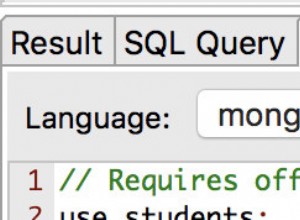W MongoDB $in Operator potoku agregacji zwraca wartość logiczną wskazującą, czy określona wartość znajduje się w tablicy.
$in Operator potoku agregacji nie powinien być mylony z $in operator zapytań, który wybiera dokumenty, w których wartość pola jest równa dowolnej wartości w określonej tablicy.
Przykład
Załóżmy, że mamy kolekcję o nazwie products z następującymi dokumentami:
{ "_id" : 1, "prod" : "Bat", "sizes" : [ "S", "M", "XL", "XXL" ] }
{ "_id" : 2, "prod" : "Hat", "sizes" : [ "S", "L", "XL" ] }
{ "_id" : 3, "prod" : "Cap", "sizes" : [ "XS", "S", "M", "L", "XL" ] }
Możemy użyć $in operator, aby dowiedzieć się, czy sizes pole zawiera wartość L .
Przykład:
db.products.aggregate(
[
{
$project:
{
hasLarge: { $in: [ "L", "$sizes" ] }
}
}
]
)Wynik:
{ "_id" : 1, "hasLarge" : false }
{ "_id" : 2, "hasLarge" : true }
{ "_id" : 3, "hasLarge" : true } Drugi argument musi zostać rozwiązany w postaci tablicy
Drugi argument $in operator musi rozwiązać do tablicy. Jeśli tak się nie stanie, zwracany jest błąd.
Załóżmy, że dodajemy do kolekcji następujący dokument:
{ "_id" : 4, "prod" : "Shirt", "sizes" : "L" }
Zwróć uwagę, że sizes pole nie jest tablicą – to ciąg znaków.
Zastosujmy $in do tego dokumentu:
db.products.aggregate(
[
{ $match: { _id: { $in: [ 4 ] } } },
{
$project:
{
hasLarge: { $in: [ "L", "$sizes" ] }
}
}
]
)Wynik:
Error: command failed: {
"ok" : 0,
"errmsg" : "$in requires an array as a second argument, found: string",
"code" : 40081,
"codeName" : "Location40081"
} : aggregate failed :
[email protected]/mongo/shell/utils.js:25:13
[email protected]/mongo/shell/assert.js:18:14
[email protected]/mongo/shell/assert.js:618:17
[email protected]/mongo/shell/assert.js:708:16
[email protected]/mongo/shell/db.js:266:5
[email protected]/mongo/shell/collection.js:1046:12
@(shell):1:1
W tym przypadku sizes pole zawiera ciąg znaków, dlatego zwracany jest błąd.
W tym przykładzie używam również $in z $match operator w celu filtrowania dokumentów tylko do tych, którymi jestem zainteresowany. Zauważ, że używa on $in składnia operatora zapytania, która przyjmuje jeden argument i nie należy jej mylić ze składnią dwuargumentową.
Wartości puste
To samo stanie się, jeśli drugim argumentem będzie null .
Dodajmy do kolekcji następujący dokument:
{ "_id" : 5, "prod" : "Jeans", "sizes" : null }
Oto, co się stanie, jeśli spróbujemy użyć $in z tym dokumentem:
db.products.aggregate(
[
{ $match: { _id: { $in: [ 5 ] } } },
{
$project:
{
hasLarge: { $in: [ "L", "$sizes" ] }
}
}
]
)Wynik:
Error: command failed: {
"ok" : 0,
"errmsg" : "$in requires an array as a second argument, found: null",
"code" : 40081,
"codeName" : "Location40081"
} : aggregate failed :
[email protected]/mongo/shell/utils.js:25:13
[email protected]/mongo/shell/assert.js:18:14
[email protected]/mongo/shell/assert.js:618:17
[email protected]/mongo/shell/assert.js:708:16
[email protected]/mongo/shell/db.js:266:5
[email protected]/mongo/shell/collection.js:1046:12
@(shell):1:1 Ten sam błąd.
Brakujące pola
To samo dotyczy brakujących pól.
Załóżmy, że do naszej kolekcji dodamy następujący dokument:
{ "_id" : 6, "prod" : "Shorts" }
A teraz próbujemy zastosować $in do (nieistniejących) sizes pole:
db.products.aggregate(
[
{ $match: { _id: { $in: [ 6 ] } } },
{
$project:
{
hasLarge: { $in: [ "L", "$sizes" ] }
}
}
]
)Wynik:
Error: command failed: {
"ok" : 0,
"errmsg" : "$in requires an array as a second argument, found: missing",
"code" : 40081,
"codeName" : "Location40081"
} : aggregate failed :
[email protected]/mongo/shell/utils.js:25:13
[email protected]/mongo/shell/assert.js:18:14
[email protected]/mongo/shell/assert.js:618:17
[email protected]/mongo/shell/assert.js:708:16
[email protected]/mongo/shell/db.js:266:5
[email protected]/mongo/shell/collection.js:1046:12
@(shell):1:1 Wyrażenia regularne
W przeciwieństwie do $in operator zapytania, $in Operator potoku agregacji nie obsługuje używania wyrażeń regularnych.
Dlatego poniższy kod nie powoduje dopasowania:
db.products.aggregate(
[
{ $match: { _id: { $in: [ 1, 2, 3 ] } } },
{
$project:
{
hasLarge: { $in: [ /^X/, "$sizes" ] }
}
}
]
)Wynik:
{ "_id" : 1, "hasLarge" : false }
{ "_id" : 2, "hasLarge" : false }
{ "_id" : 3, "hasLarge" : false }
Wynik dla wszystkich dokumentów to false , mimo że sizes pole we wszystkich trzech dokumentach zawiera elementy tablicy, które zaczynają się od wielkich liter X .




